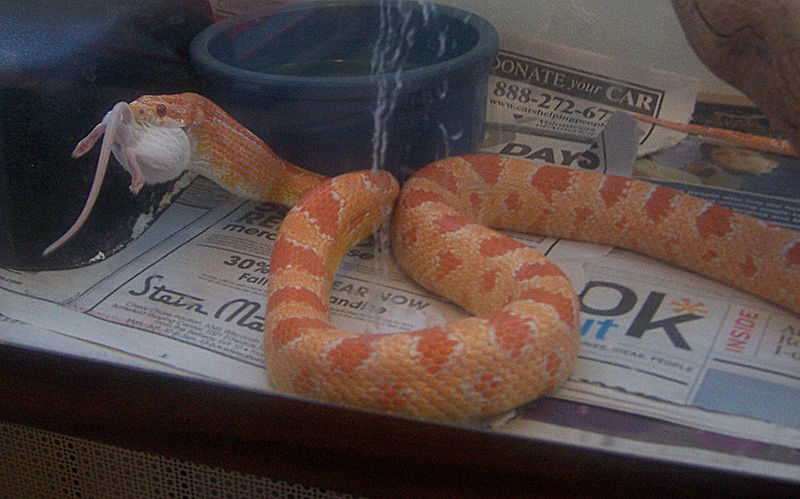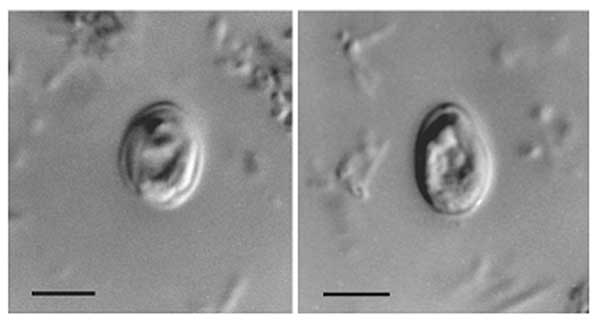 A decade or so ago, Cryptosporidiosis became recognized as a major concern in captive snake and lizard collections. Caused by a one-celled parasite known as Cryptosporidium varanii, the disease remains incurable to this day. At the Bronx Zoo, where I worked at the time, tests showed that many snakes already in our collection, along with wild and pet reptiles, might be harboring Cryptosporidium. But diagnosis was difficult and errors were common, resulting in the institution of expensive and time-consuming isolation protocols for new and sick animals. So I was happy to learn of a newly devised test that ensures early, accurate diagnosis of Cryptosporidium…it will surely prove useful to pet keepers and zoos alike.
A decade or so ago, Cryptosporidiosis became recognized as a major concern in captive snake and lizard collections. Caused by a one-celled parasite known as Cryptosporidium varanii, the disease remains incurable to this day. At the Bronx Zoo, where I worked at the time, tests showed that many snakes already in our collection, along with wild and pet reptiles, might be harboring Cryptosporidium. But diagnosis was difficult and errors were common, resulting in the institution of expensive and time-consuming isolation protocols for new and sick animals. So I was happy to learn of a newly devised test that ensures early, accurate diagnosis of Cryptosporidium…it will surely prove useful to pet keepers and zoos alike.
Crypto and the Pet Trade
A number of factors render Cryptosporidiosis as a major concern, including the popularity of reptile pets and the fact that the parasite can be transferred to people. While not often of major concern to healthy adults, Crypto, as it came to be known, is a danger to immune-compromised individuals (please see article below). A recent survey of 672 pets revealed that 1 in 6 of the Corn Snakes and 1 in 12 of the Leopard Geckos tested harbored Crypto in one form or another.
Crypto is the most common cause of a Leopard Gecko ailment popularly known as “Stick Tail Disease”. The parasite dwells in the small intestine, where it prevents proper absorption of food; various bacteria to take hold as well, due perhaps to damage inflicted on the intestinal walls. Loose stools and weakness follow, and the gecko’s thick tail (which stores fat) wastes away to a mere “stick”. Crypto has caused similar problems in Gila monsters, monitors, chameleons and other species.
Crypto is passed in the feces (in a form known as an oocyst) and can remain alive for years until a host is found. Oocysts are difficult to kill other than by steam, undiluted ammonia and certain disinfectants not generally available to hobbyists.
Crypto in Zoo Animals and Wild Populations
Declining populations of many snakes and lizards makes zoo-based breeding programs all-the-more vital. However, Crypto is incurable; the many zoo animals that now harbor it must be isolated, and cannot be bred as the young will likely be infected as well.
The Importance of the New Test
The first Crypto tests, based on fecal samples, were unreliable because the parasite often appeared sporadically, or in minute populations, and so was easy to miss. Also, related parasites infect the foods eaten by snakes and lizards, and distinguishing between the species of Cryptosporidium present was nearly impossible.
Researchers at the University of Veterinary Medicine in Vienna have recently devised a DNA-based test that quickly and accurately reveals the presence of Cryptosporidium parasites (please see article below). The test also allows one to determine whether the parasite is present in the snake or lizard, or entered via the animal’s food.
Caring for Crypto-Positive Reptiles
 Early detection is important because there are medications, such as Paromomycin, that can keep Crypto populations low enough to allow the infected reptile to survive. However, treatment is only effective if instituted within a certain time frame.
Early detection is important because there are medications, such as Paromomycin, that can keep Crypto populations low enough to allow the infected reptile to survive. However, treatment is only effective if instituted within a certain time frame.
Crypto-positive reptiles cannot be cured at this time, and will require lifelong treatment and special care. Dr. Kevin Wright of the Arizona Exotic Animal Hospital has written an excellent paper on this subject (please see below); please read it to learn more about caring for such animals and preventing Crypto transmission.
Further Reading
Crypto in Leopard Geckos (Arizona Exotic Animal Hospital)
Crypto/Microsporidium in Bearded Dragons
 That Reptile Blog – Reptile, Amphibian and Exotic Pet Care and Information
That Reptile Blog – Reptile, Amphibian and Exotic Pet Care and Information



I’m soo into reptiles, i’m gonna study to be a vet, and i had a snake one year ago, his name was Zimba, he was a “swedish gardersnake” 🙂 love your blog btw.
Hello Amanda,
Thanks very much for the kind words. Vet school is a wonderful idea…reptile/amphibian medicine and zoo animal medicine is a fast-developing specialty; I worked with several reptile vets at the Bronx Zoo; some of them also participated in field research, along with herpetologists.
Here is a 2 Part article on Careers in Herpetology that you might enjoy. You will also find useful information on the website of the Association of Reptile and Amphibian Veterinarians.
Please let me know if you need any further information. Good luck, enjoy and please keep me posted.
Best regards, Frank Indiviglio.
Don’t use commercially prepared, dry, or pelleted foods. Succeeding feeding all through out the day can also be done but only in small quantity. If you have a baby, you should start out by bathing him for ten minutes or so.
” the many zoo animals that now harbor it must be isolated, and cannot be bred as the young will likely be infected as well.”
How can crypto be passed from mother to eggs? If the eggs/hatchlings are separated from other animals how can they possibly get crypto?
Hello,
Thank you for your interest. Transfer may occur upon hatching, via contact with the egg shell. Also, organisms as large as Phorid fly larvae can enter some reptile eggs via the air pore; I have not checked if this has been documented for Cryptosporidium. best, Frank
I’m in the U.S. Where can I get my corn snake collection tested for crypto using this new method? What is the co$t to do these test? Thank you.
Hello Bill,
It would be best to check with a lo\cal reptile-experienced vet..let me know if you need listings for your state, best, Frank
Hello again Frank. Watching this video ( https://www.youtube.com/watch?v=L1F_LWMIPDY ) gave me an idea. Crypto can not be passed from mother to baby but the protozoan can live on the surface of the egg if the mother was infected. Then when the baby hatches out it comes into contact with the crypto protozoa and is infected. Hydrogen peroxide is known to kill crytpo, at least that’s what I’ve been told, so I’m thinking if you sprayed the entire egg with hydrogen peroxide it may kill the crypto and the baby would be safe from catching the deadly crypto disease upon hatching. But, I’m wondering if spraying the entire egg would kill the baby embryo inside? I have a corn snake that is gravid right now. I think I’ll take a few of her eggs and do the experiment. This could be the answer to the crypto problem. This of course depends on the protozoan not entering through the porous egg shell. What do you think Frank?
Hello Bill,
Interesting ideas, thanks.
I can’t say for sure, but organisms as large as phorid fly larvae can enter eggs (of some turtles,. at least) via the air pores, so I’m guessing that micro-organisms of most types can do the same.
Peroxide would likely enter as well, or clog the pores, and research would be needed re necessary exposure time, etc. Recently, turtle farmers in Louisiana have been experimenting with irradiation of various types in order to produce, if possible, Salmonella free hatchlings. Shows promise, but I do not know if would be applicable here.
Please keep me posted, beat,. frank